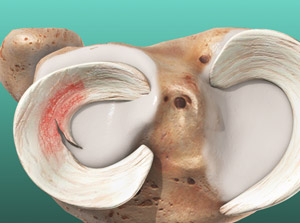The meniscus is a specialized fibrocartilaginous structure situated between the femur (thigh bone) and tibia (shin bone).
Each
knee has two semilunar (C-shaped) menisci situated on the inside and
outside of the knee joint, referred to as the medial and lateral
menisci, respectively. The meniscus attaches to the bone with
insertional fibers and several attachments to the ligaments that make up
the knee. The meniscus provides mechanical support cushion to the knee
by distributing forces across the joint, assisting with load bearing
and providing lubrication for smooth movement in the joint. The
meniscus also serves as an additional stabilizer to the knee, and
studies have shown that a torn ACL with a damaged meniscus has a much
higher risk of instability when compared to an ACL tear alone.

What is it?
A menicus tear is a common injury of the knee. Your knee joint is cushioned by two c-shaped wedges of cartilage called the "menisci." Each individual cushion is called a "meniscus." This injury is a tear of one of these cushions.
What causes it?
A meniscus injury can be caused by a partial or full tear of the cartilage that results from trauma or twisting of the knee. Tears can occur in several directions and can be described as longitudinal, radial, parrot-beak, horizontal, and bucket-handle. Meniscus injuries can also be degenerative and are commonly associated with osteoarthritis. Tears in the meniscus cause pain, occasional swelling, mechanical symptoms (sensation of catching, clicking, or locking in the knee), and occasionally limitations in motion.
Signs & symptoms
Diagnosis of a meniscus tear requires a thorough examination and detailed assessment of radiographs (X-rays) and MRI scans. Treatment is dependent on the patient, his or her activity level, and importantly the presence or absence of arthritis.
Non-Surgical Treatment
Non-surgical treatment options will focus on alleviating symptoms but will not facilitate healing of the tear.
Activity modification - Initially, the activity causing the condition should be limited. Limiting the aggravating activity, not total rest, is recommended.
Medication - anti-inflammatory medications (NSAIDs) may help alleviate the pain.
Brace - a knee brace can reduce the tension and allow it to heal.
Physical Therapy - may be helpful, providing stretching and/or strengthening exercises. Modalities such as ultrasound or heat treatments may be helpful.
Steroid injections - a steroid is a strong
anti-inflammatory medication that can be injected into the area. No more
than (3) injections should be given.
Surgical Treatment
If non-surgical treatments fail to alleviate pain and symptoms, then surgical treatment may be indicated. Surgical treatment of meniscus tears is performed arthroscopically and includes a meniscectomy (torn tissue is trimmed away) and/or a meniscus repair (sutures are inserted to stabilize the tear). The location of the tear and the amount of blood supply to the tissue will determine if the meniscus can be repaired or must be trimmed out. In certain circumstances, a meniscus tear can be large enough and irreparable, leaving the knee without enough meniscus to protect the cartilage of the knee joint (meniscal insufficiency). In the properly selected patient, a meniscus transplant can be performed, providing the patient with a new, cadaver meniscus.
At The Knee Center at Andrews Sports Medicine, our fellowship-trained non-surgical physicians and orthopaedic surgeons provide the most-advanced, comprehensive treatment solutions for injuries and disorders of the knee. To schedule an appointment, call (205) 939-3699.
Request an Appointment OnlineBack to Knee







